Details to think about when designing an Emergency Action Plan (EAP) for a pool, written with the coaches and instructors I teach Basic Water Rescue and/or Lifeguard Training to in mind, but that could certainly apply to families or companies as well.
An emergency action plan should be a simple, easy to remember, written plan that directs the actions of individuals responding to an emergency. To be most effective the plan should be practiced regularly, as in this example below at Saratoga High School:
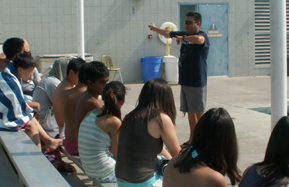
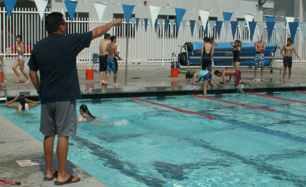
Every facility should have a general emergency action plan and at a minimum should have worked out in advance:
Who makes what decisions and who has the final say?
Who is the spokesperson?
What are lifeguard’s, management’s and your responsibilities during and after each potential emergency?
Where do you evacuate students to and where is the second place if that one is unavailable? When do you evacuate or stay put? (When the administration notifies you, as in a bomb threat, civil disturbance, fire; or do you decide, as in a power failure, chemical spill, fight, violent intruder, drive-by-shooting?)
Did your facility work with local police, fire and county officials to identify weather and man-made emergencies common or uncommon to the area, and prepare response plans together? Under what circumstances will they take over completely or expect/allow you to assist? Do you know if EMS personnel are trained/equipped to enter the water? Has the local unit most likely to respond been to the facility and do they know at the least how to get to your pool and access entry/exit routes? Will a gurney/backboard fit in any elevator you might have or do you need to figure out a different route? Can you work with your certified pool operator to learn about chemical handling issues?
Can people swim during a bad / smoky air day from wildfire smoke? Air Quality Index Levels of Health Concern are listed at https://www.airnow.gov/ where you can search by zip code, and there is a chart of what outdoor activities are considered safe, unsafe, not recommended, etc. at: https://www3.epa.gov/airnow/flag/school-chart-2014.pdf which includes, for “unhealthy air” conditions, as often occurs many miles from wildfires, “For all outdoor activities, take more breaks and do less intense activities. Consider moving longer or more intense activities indoors or rescheduling them to another day or time. Watch for symptoms and take action as needed.*Students with asthma should follow their asthma action plans and keep their quick-relief medicine handy.”
In an all out emergency such as after an earthquake/during a fire, when security (and possibly EMS) will be quite busy and not able to respond to you, do you have a backup plan for things they would normally carry out? Besides sufficiently mature and responsible students, do you know what other staff might be nearby and able to help if you had included them in your personal emergency action plan? They could include a coach/instructor in the nearby gym, non-PE instructors in nearby classrooms, cashiers, clerical, custodial, maintenance. Can you take a moment in advance of trouble to show them how to help you get a non-spinal injury victim out of the pool using a backboard? How to remove a victim from the pool . Have you rehearsed a quick description of how to do it to use during an emergency when you need to suddenly teach another person how to help you?
Be sure many types of emergencies are addressed in your plan:
• Severe weather
for example:
lightning – clear the pool at the first sight of lightning or sound of thunder and keep it cleared until 30 minutes after the last sight of lightning or sound of thunder and do not use showers or a phone connected to a land line or your iPod.
heavy rain/hail: if you can’t see below the surface people should not be swimming – this includes mornings when the pool surface ‘fog’ is too thick.
and natural disasters (for example: an earthquake will cause a tidal wave in your pool and you might have a swimmer pushed against the pool wall hard enough to break a leg. The water level may be so low after the shaking settles down that people still in a deep pool or diving well can’t reach the pool ladder, so you need a plan and equipment to get them out in advance.)
• Aquatic emergencies
• Injuries either in or out of the water
• Sudden illnesses, including seizures in the water ( get their face out of the water ASAP and assume they may have breathed in water and therefore must get to the emergency room ASAP)
• Facility problems, such as fire, power failure or a chemical spill/explosion, fire nearby that presents danger from smoke
• Missing persons (Do a visual search of the pool surface and bottom immediately, then consider other places the person might be.) People should never swim in a pool with the pool cover on, even partially covering the pool.
• Disruptive behavior
• After a vomit or fecal accident (formed or diarrheal) the pool must be immediately cleared of and closed to swimmers. (Even after the fecal material has been cleaned from the water, it can require from 1 hour to 13+ hours of a higher than normal concentration of pool chemicals, so the pool custodians need to be called right away.)
Phone numbers that need to be readily available:
(Remember, you can’t always count on security or administrators being free to help you and may have to attempt to get help yourself.)
911 or any local numbers of that sort
chain of command
poison control
animal control
chemical accident hotline / hazmat response
health department
power company
pool custodians
A land line phone in a room away from the pool and safety equipment (backboard, rescue tube, flashlight (electric torch) ) that is locked up or missing parts is of no use in an emergency.
Staff Roles and Responsibilities
A key element of emergency planning is to identify roles and responsibilities of instructors, coaches, staff, security and swimmers/students during an emergency, especially if you do not have lifeguards or only have one lifeguard on duty. Students at a school can be a part of an EAP, but you need to decide in advance what they can do and how much responsibility to give them and practice what they need to do. A team captain might have different responsibilities than others. (A student who gets excited and runs out into traffic needs to be prevented.)
• What prompts an action? Usually the coach/instructor will assess the situation and determine what actions are necessary. But consider this potential problem. Sometimes the coach/instructor will not be the first person to identify someone in trouble and a student/swimmer might try to help, get too close to the swimmer in trouble and be grabbed, resulting in two people drowning. Prevention is the key to preventing this and can only be done if the class/team has had a minimum training in what is expected in an emergency.
• How will the person who recognizes an emergency signal to others?
• If a lifeguard, coach or instructor goes in the pool, who covers for the rescuer?
• Who clears the pool? Under what circumstances are the students not involved moved to the locker rooms or to…?
• Who assists the primary rescuer by bringing equipment, if needed? Does everyone know where the rescue equipment is? Is anything crucial usually locked up and in need of being taken out to the pool deck each day? Is there a emergency switch to shut down pool filter, spa, and is it readily accessible?
• Who calls EMS personnel (911) security or support staff, if necessary?
• Who meets EMS personnel and where? Is this carried out by security, and again, do you have a backup plan for an all out emergency such as after an earthquake/during a fire, when security will be quite busy and not able to respond to you?
• Who controls the crowd?
Students and team members involved will need to be interviewed for the accident report. This needs to be done immediately after the accident as memories fade quickly. It takes time because accurate detail is critical.
Practicing Your Plan
To work effectively when an emergency does occur, an EAP must be practiced regularly for everyone to truly be ready to respond.
Periodically ask local emergency personnel to help you rehearse emergency plans, if possible, and hold
drills for all staff involved. After each drill, in addition to discussing what went well, encourage lifeguards and other staff to suggest possible improvements. Document these drills and note who was involved, including supporting personnel outside the facility.
More potential preparation:
Does the school health official, a coach or administrator already have the answers to most of the questions an EMT would ask a victim, (in case the victim is unconscious or other wise unable to answer them), such as
Do you have any allergies, (including food, plants, insects and medications)? What type of reactions have you experienced when you were exposed?
Do you have any medical conditions or are you taking any medications? If so, what conditions do you have or what medications are you taking?
The entire list of questions to get the answers to before the victim passes out is at first aid Secondary Assessment
Notice that some of them could be in a written record in advance, but others need to be asked at the time of an accident/injury, such as:
What happened to you?
Do you feel any numbness, tingling or loss of sensation? If so, where?
Do you feel pain anywhere?
What medications have you taken in the past 12 hours?
When did you last eat or drink anything? What did you last eat or drink?
What were you doing before the accident happened? What were you doing when the incident occured?
Finally, you could ask: Is there anything else I should know?
Write down all the answers.
Does the school health official, coach or administrator already have an accurate description (and photo) of a potentially missing person?
AFTER the emergency:
When the emergency is over, you may need to assist with follow-up
procedures. Your school should have a written plan for who is responsible for:
o Confirming that witnesses have been interviewed and their observations documented in writing.
o If 911 did not respond, when/how do you report the incident to the authorities?
o Contacting a victim’s family/guardian.
o Dealing with the media. If a TV camera is put in your face and you are asked questions you know you should not give answers to (privacy issues, risk management issues, insurance issues, etc.) and you say “No Comment” it can end up sounding when played on the evening news as if you were hiding something. A better answer could be “the person you need to talk to is Mike Smith, the Principal.” This person should be designated in advance.
You could have a written policy that permission of management is required before anyone is allowed to take pictures, audio or video recordings inside your facility.
o Inspecting equipment and supplies used in the emergency. Replace any used supplies. Make sure that all the equipment used is back in place and in good working condition. For example, you should not open the pool again if the only backboard was taken away until it is replaced.
o Filling out any report forms and transmitting the reports appropriately. All injuries and incidents should be documented and reported. These reports may be used for insurance purposes and in a court of law. They should be filled out promptly, not just when you suspect that you might be sued.
o Assessing what happened and evaluating the actions taken, then redesigning your emergency action plan if necessary. What new ways to prevent issues could be put in place or how could rules be better explained / enforced?
___________________________________________
And finally, think through all this again for when you are at an away meet/game or on campus not during normal school hours, or hear an emergency in the nearby playground or parking lot.
___________________________________________
When you call 911 from a land line telephone, such as in your house or at the pool, you get dispatch for the city the phone (your house/school) is located in. When you call 911 from a cell phone in almost all cases you get the Highway Patrol at a central location. Sometimes, especially if you are not calling about something on the freeway/highway, it would be faster to get dispatch for the specific city the problem is happening in. This requires knowing the direct dial seven digit phone number for each dispatch.
Direct dial emergency phone numbers for most cities in Santa Clara County, California, can be found at the Santa Clara County ARES/RACES (Amateur Radio Emergency Services/Radio Amateur Civil Emergency Services) website.
http://www.scc-ares-races.org/dd-emer-nos.html
San Mateo County cities (and the San Francisco airport) direct dial phone numbers can be found at:
http://www.blackberryreact.org/smco911phones.html
When you are planning an away game/meet, try to get the direct dial number for that city before you go.
and see: How To Call 911
Glass containers are not allowed. Water in plastic bottles is permitted. (The reason behind no glass containers is that if broken, it is nearly impossible to clean up all the glass fragments, and swimmers often have bare feet.)
Goggles should not be worn to dive or to swim to a depth greater than 5 feet.
The Red Cross warns: Goggles “are not made for underwater swimming. There is no way to equalize the pressure inside the goggles with the increasing pressure outside the body. The air volume inside the goggles tends to compress. This compression tends to “pull” the eyeball out of the socket to effectively reduce the trapped air volume. If swimmers spend time below the surface of the water wearing goggles they may pop blood vessels in their eyes. Goggles should not be worn for underwater swimming … Submerging to a depth of 5 feet or greater has the potential to cause barotraumas to the eye of an individual wearing swim goggles that cannot be pressure equalized.” The Red Cross also warns, in a swim instructor manual safety note “Do not allow participants to wear goggles while practicing any of the diving skills.”
Wearing contact lenses to swim is dangerous. The Red Cross warns: “Swimmers with contact lenses should remove them before opening eyes underwater.” Pool chemicals can damage some kinds and others will absorb bacteria, leading to infection. All brands of goggles can leak or slip off and do not fully protect contact lenses.
Swim students should not use earplugs. In deep water earplugs can be forced by water pressure into your ear. The Red Cross warns: “Do not wear earplugs; pressure changes make them dangerous.”
Floating idly in the pool can be quite relaxing. Feel the sunshine on your back, stare at the bottom. But out of courtesy to others, so your instructor, coach, the lifeguard or other swimmers won’t wonder if you are capable of holding your breath for a long time or if you have really passed out, any person who wants to float without moving should signal that they are okay by giving a ‘thumbs-up’ signal. Even if others at the pool you are at are not familiar with this courtesy, they should be able to understand it.
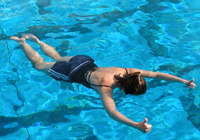
Kick boards can be dangerous used as toys. When a person tries to stand on, kneel on or sit on a kickboard and loses control of it, it can come to the surface with enough force to knock out teeth.
Hand paddles are too dangerous to use when sharing a lane. Some pool also say fins should not be used when sharing a lane.
Red Cross Water Safety Instructor’s manual, 2009: Minimum depth of water under a 1 meter diving board directly under the tip of the board should be 11 feet 6 inches. Minimum depth to teach diving from the side of a pool (racing dives) should be 9 feet. Goggles should never be worn during teaching of head first entries.
Diving Board rules
Only one bounce allowed on the diving board.
Only one person on the diving board at a time. This means people
should wait at the bottom of the ladder until the person
jumping or diving has done so, and is clear.
Don’t run on the board or attempt to dive a long way through the air.
Swim away from the board immediately after diving so you aren’t a hazard for the next diver and so you are safe if the next diver doesn’t make certain the water is clear.
Jump or dive only from the end of the board. Don’t use the guardrails for gymnastics. Trick dives only with permission.
NEVER perform a head-first entry, from the side of the pool or a diving board: Over stationary objects, Over any hard device, such as a pole, Through inner tubes or hoops
swim class safety rules , a reading assignment for all my swim students.
Accident prevention tips that USA Swimming coaches know:
Take a look around each day and make sure there are no unusual hazards or obstacles on deck. Alert people about any you can’t correct, and/or cone off things like cracked tiles.
Explain all rules of games thoroughly. Anticipate an accident such as a blindfolded Marco Polo swimming into the wall and use lane lines to prevent it. (and even better – trust the player to keep eyes closed rather than actually blindfolding him/her so they can look when they need to.)
Always enforce a feet first entry into the water and that swimmers look at the surface and below surface before entering.
Starting blocks should only be used by skilled swimmers, under direct supervision. When not in use they should be covered or removed so they are not a temptation to casual users.
Be sure backstroke flags are in place and your students know how to use them to predict when they will get to the wall.
Wires should not be laid on deck. Hang them overhead to prevent tripping hazards.
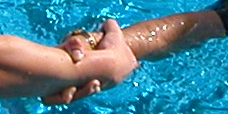 How to rescue a drowning victim using a reaching assist or a shepherd’s crook
How to rescue a drowning victim using a reaching assist or a shepherd’s crook
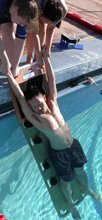 How to remove a victim from the pool
How to remove a victim from the pool
____________________________________
More examples of removals from the water taught in the class:
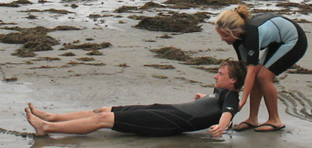 A beach drag is used in shallow water on a sloping shore or beach, or a zero depth exit at a pool. It works well with a heavy or unconscious victim. Do not use a beach drag if you suspect the victim has a head, neck or back injury.
A beach drag is used in shallow water on a sloping shore or beach, or a zero depth exit at a pool. It works well with a heavy or unconscious victim. Do not use a beach drag if you suspect the victim has a head, neck or back injury.
One or two rescuers can stand behind the victim and grasp him or her under the armpits. Support the head with your forearms. Walk back slowly and drag the victim onto the shore. Use your legs and not your back. Pull the victim completely out of the water if you can, but at least get the victim’s head and shoulders out of the water. If someone else is ready to help, drag the victim out together.
On a sloping beach, with an unconscious victim or a victim in shock, turn them as you reach shore so that they are parallel to the shore. If you drag them up without turning them their head will be higher than their feet, the opposite of treating for shock and if you need to give CPR the blood will not flow where you want it to.
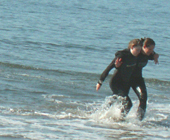 A walking assist is used for a victim who is in shallow water at a pool or waterfront, who can stand and may be able to walk with your help.
A walking assist is used for a victim who is in shallow water at a pool or waterfront, who can stand and may be able to walk with your help.
Place one of the victim’s arms around your neck and over your shoulder. Hold the wrist of the arm that is over the shoulder, and wrap your free arm around the victim’s back or waist. Hold the victim firmly and help him/her walk out of the water. If someone else is ready to help, help the victim out together.
____________________________________
examples of assists:
 Throwing Assists
Throwing Assists
Use a throwing assist to rescue someone beyond your reach in a pool or open water. Throw a buoyant object tied to a line to the victim. S/he can grasp the object and be pulled to safety.
Throwing equipment potentially includes:
Heaving lines
Ring buoys
 Throw bags
Throw bags
Rescue tubes
Homemade throwing devices, such as a heaving jug
Any floating object at hand, such as a picnic jug, small cooler, buoyant cushion, kickboard or extra life jacket
Throwing equipment such as ring bouys can usually be found in plain view at swimming pools and public waterfronts.
To perform a throwing assist
1. Get into a stride position: The leg opposite your throwing arm is
forward. This helps to keep your balance when you throw the object.
2. Step on the end of the line attached to the ring buoy/ heaving line/ heaving jug with your forward foot. Avoid stepping on the coiled line with the other foot.
3. Shout to get the victim’s attention. Make eye contact and say that you are going to throw the object now. Tell the victim to grab it. (They might not be able to hear you or respond to you.)
4. Bend your knees and throw the object to the victim. Try to throw the object upwind and/or up current, just over (past) the victim’s head, so that the line drops within reach. If the victim does not immediately notice and grab the line, move yourself on the deck/ on shore so you can pull the line to get the object under the victim’s hand/arm.
5. When the victim has grasped the object or the line, slowly pull him or her to safety. Lean away from the water as you pull.
6. If the object does not get out as far as the victim, quickly pull the line back in and throw it again. Try to keep the line from tangling, but do not waste time trying to coil it. If using a throw bag, partially fill the bag with some water and throw it again.
Wading Assist with Equipment
If the water is safe and shallow enough (not over your chest), you can
wade in to reach the victim. Do not enter the water if there is a strong
current, if the bottom is soft or if you do not know the condition of
the bottom.
If possible, you should wear a life jacket when attempting a wading
assist, and take something to extend your reach.
___________________________________________
Self rescue wearing a lifejacket:
To conserve body heat while awaiting rescue in cold water, use the HELP position —the heat escape lessening posture to reduce the amount of body surface exposed to cold water. When two or more people wearing life jackets find themselves in cold water, the huddle position will help them conserve body heat while awaiting rescue.
(Fremont Union High School District coaches Kiernan Raffo, J C Hovland, Jill Borges and Jeremy Kitchen posed for these photos.)
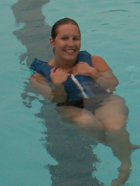 HELP (heat escape lessening posture) Position
HELP (heat escape lessening posture) Position
- 1.Draw your knees up to your chest.
2.Keep your face forward and out of the water.
3.Hold your upper arms at your sides, and hold your lower arms against or across your chest.
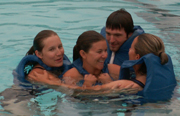 Huddle Position
Huddle Position
-
- 1. With two people, put your arms around each other so that your
- chests are together.
2. With three or more people, put your arms over each other’s
shoulders so that the sides of your chests are together.
Children or elderly persons should
be placed in the middle of the huddle.
_________________________________________________________________
Also of potential use:
Neighborhood Watch applied to swim centers
CPO What a certified pool operator (CPO) knows that lifeguards and swimmers should know.
_________________________________________________________________
a brief lesson in electricity. When you plug an appliance into a wall outlet and turn it on, it does not use up all the electricity coming to it. The electricity returns into the wall outlet. A special type of outlet, a ground fault circuit interrupter (GFCI), constantly monitors the returning current. If the current does not return because it goes to ground… (for example through you or other people), because you:
put a boom box on a starting block next to a swimming pool and it falls in, then sending the electricity into the pool water and the aqua aerobics class members
or
work out in the rain with a power tool that has a frayed wire and the wet ‘hot’ wire sends the electricity into you
or
don’t have a long enough ‘suitable for use with outdoor appliances’ extension cord, so you string together a few that are not labeled for outdoor use, and not suitable for the distance/wattage of the mega-bright decorating lights you want to use, and the cord comes in contact with puddles on the deck and sends electricity into the water/people
… the GFI can prevent electrical shock by noticing the difference in the current and shutting off the current to the appliance/power tool (in as little as one-thirtieth of a second!).
 Please note that GFIs can be damaged by lightning or other electrical surges and need to be tested regularly. Since they might not always be functional, putting that boom box/radio/hairdryer where it can fall in the swimming pool/spa/hot tub/bathtub/kitchen sink full of water is never a good idea.
Please note that GFIs can be damaged by lightning or other electrical surges and need to be tested regularly. Since they might not always be functional, putting that boom box/radio/hairdryer where it can fall in the swimming pool/spa/hot tub/bathtub/kitchen sink full of water is never a good idea.
The author of this webpage, (written as a homework reading assignment for my students), does not give any warranty, expressed or implied, nor assume any legal liability or responsibility for the accuracy, completeness, or usefulness of any information, product, or process included in this website or at websites linked to or from it. Users of information from this website assume all liability arising from such use.